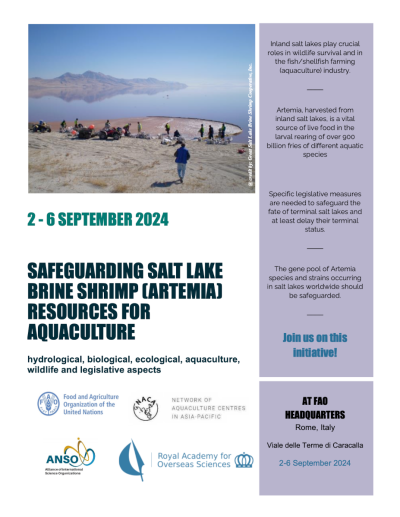Safeguarding salt lake brine shrimp (Artemia) resources for aquaculture: A training project
10 May 2024 | .pdf | 375.22 KB | Genetics and biodiversity, Environment and sustainability, Artemia
A training project addressing Artemia management and conservation from hydrological, biological, ecological, aquaculture, wildlife and legislative perspectives will be held in Rome, Italy, from 2-6 September 2024. The training is being organised by the Food and Agriculture Organization of the United Nations (FAO) and the Network of Aquaculture Centres in Asia-Pacific (NACA), with the financial support of the Alliance of National and International Science Organizations for the Belt and Road Regions (ANSO) and the Royal Academy for Overseas Sciences (RAOS), in cooperation with the International Artemia Aquaculture Consortium (IAAC). The project will address hydrological, biological, ecological, aquaculture, wildlife and legislative aspects of Artemia management and conservation.
Many salt lakes on different continents are under threat of drying up because of human interventions and/or climate change events. Different species of brine shrimp are the sole zooplankton developing in dense monocultures in these inland salt lakes and play crucial roles in wildlife survival and are an important resource to the global fish/shellfish farming (aquaculture) industry:
- Artemia biomass is a crucial source of high-protein food for millions of migrating birds foraging in transit during certain periods of the year.
- Thousands of tonnes of Artemia cysts (0.5-mm inactive embryos) are harvested from salt lakes in North America and Asia annually for use as a vital zooplankton substitute in the larval rearing of over 900 billion larvae and fry of different aquatic species that eventually yield more than 10 million tonnes of seafood produced in the aquaculture industry.
In recent decades, a few terminal salt lakes have already dried up (e.g. Aral Sea in Uzbekistan, Urmia Lake in Iran, Owens Lake in the United States of America) with very significant impacts on wildlife and human health, as well as important economic losses (in the billions of USD). On the other hand, new salt lakes may emerge or be restored in new or dried-up locations due to climate change.
Multidisciplinary efforts to better understand hydrological, biological, and ecological events - with the Great Salt Lake in Utah as a unique test case - can deliver insights and allow the formulation of specific legislative measures to safeguard the fate of terminal salt lakes and at least delay their terminal status.
The gene pool of Artemia species and strains occurring in salt lakes worldwide need to be safeguarded and better characterised for use in aquaculture. The ecological heterogeneity and dynamics of salty lakes, influenced by climate change and human intervention, have left genetic signatures in the Artemia genome that require an integrated/coordinated approach.
Through this training session, the International Artemia Aquaculture Consortium (IAAC), a subject-oriented network of NACA, is following up on recommendation 16 of the 11th Session of the Sub-Committee on Aquaculture of the Committee on Fisheries (COFI:AQ) (Rome, May 2022) “…The Sub-Committee appreciated the work on Artemia and supported FAO efforts to explore development of technologies and sustainable management of Artemia resources” and paragraph 69 of the 12th Session of COFI:AQ (Hermosillo, May 2023) “… recommended the preparation of protocols on sustainable harvesting practices of wild resources, … and certification of cyst products… furthermore, new initiatives are vital to conserve Artemia biodiversity, …”.
Objectives of the training
- Identify inland salt lakes with Artemia populations that either have disappeared in recent years, or that are under (short/long-term) threat, and in both cases try to identify the causes for their disappearance or threat with focus on hydrological, biological ecological and climate changing aspects.
- Evaluate methodologies that have been developed to safeguard lost habitats.
- Review the long-term approach taken by different organisations in the State of Utah (United States of America) to protect the Great Salt Lake habitat and its resources (for wildlife and for the aquaculture industry).
- Review similar approaches undertaken for the protection of other salt lakes in Asia.
- Review the characterisation, monitoring and safeguarding of the gene pool of native and non-native Artemia species and stocks occurring in salt lakes, including guidelines for characterisation of genetic resources and the establishment of an Artemia cyst bank.
- Brainstorm development of knowledge products that can enhance future management of inland salt lakes including protocols, suitable legislation and training programs, leading to improved water and nutrient management to protect the endemic Artemia gene pool and manage the resource effectively.
The detailed programme is available from the link below.
Publisher: Network of Aquaculture Centres in Asia-Pacific
Rights: Public domain.
